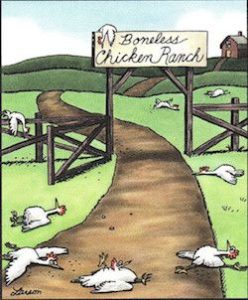Don’t Be a Boneless Chicken!
Why We at LeadingAgile Advise Starting Agile Transformation with Structure First
I grew up in the Pacific NW just south of Seattle in Tacoma, WA. One of my favorite cartoonists, Gary Larson, is from Tacoma. His cartoon The Far Side was a never-ending source of entertainment for me and later, my two boys. One cartoon that we all never seemed to tire of, answered the age-old question: “Where do boneless chickens come from?” It also led to the follow-on question of “What do boneless chickens do all day?” (Answer: Lay around wondering how they can cross the road to prove to the Possum that it can be done!).
Why is this important? How does this relate to agile? Even if we ignore for a moment the Scrum-concept of “pigs” and “chickens”; quite a lot actually.
Many companies see “agile” as a silver-bullet that can magically transform their “everyone’s busy but we’re unable to make-and-meet commitments; and when we do, its typically late and of poorer quality than we care to admit!” circumstances. Often times they think that knowledge is the answer and that simply attending agile training will be the key to their future success. Many even instantiate an “agile pilot” somewhere within their organization with their recent agile training attendees. The company decouples the pilot from all current process and “administrivia” that puts a drag on other company efforts to ensure the pilot’s success. It works!! Unfortunately, when they try to implement agile within the rest of the organization “agile” fails for them! Just like the boneless chickens in the cartoon … all knowledge and muscle without the bone structure support necessary to move successfully.
Therefore, at LeadingAgile we (highly) encourage organizations to lead with Structure, Governance and Metrics first, THEN train.
We’ve found that there are two basic areas that companies must address to be successful in applying agile at scale:
a) Willingness to establish and maintain dedicated teams; and
b) Flowing work in the form of User Stories that is ready to be pulled/delivered successfully within a sprint by Delivery Team(s).
Structure is about putting in place dedicated teams at the both the Portfolio and Program levels as well as Delivery/Service Team level. Structure in this instance is NOT about re-drawing Org Charts! It is about choosing to bring work to (teams of) people as opposed to bringing people to the work (aka “projects” / managing utilization).
Establishing dedicated team structure demonstrates the organization’s acknowledgement of and commitment to successfully connect corporate strategy/vision to execution in an agile fashion. Governance, in this paradigm, is then how each of these team’s (at each level) “work with each other”. Governance and structure together enable the organization to identify, prioritize and progressively elaborate potential work while limiting overall Work in Process (WIP). They are essential to managing risks/dependencies proactively. Putting structure and governance in place first forces conversations around dependencies (coupling) that, if ignored, put at risk the Delivery team(s) ability to successfully meet commitments. The cadence throughout this agile structure is adjusted to the proven velocity or organization’s capacity to deliver working/tested code that is ready (potentially) be deployed. Finally, Metrics enable the organization to both tie value delivered back to the overall strategy/vision as well as enable business leadership to see the agile transformation’s progress.
Structure, governance and metrics support the organization’s ability to empirically adjust as conditions dictate. They are the critical “bones” that both agile training and coaching hang from as the organization begins its agile walk. Without structure, governance and metrics already in-place the organization doesn’t have the internal support it needs to absorb and respond to the challenges and impediments that always arise when implementing change.
So go on! Ensure your agile chickens aren’t “boneless”! Your agile “pigs” will thank you!
Photo Courtesy of The Far Side © Gary Larson


Comments (3)
Andrew Petesky
Seeing that cartoon again made me laugh. I think I saw it first on greeting card.
This article strikes a lot of notes with me. I’ve seen too many pilots without the structure before or after. Yes, doesn’t work. Good stuff Jim!
Sandi
I got the link to this post from another source but knew in a few sentences it was Jim. I just finished my SPC certification so this really put into perspective the differences. I know they do a lot of work with big governement entities but SO agree with establishing dedicated teams at all levels at the start. Especially believe it’s important to start with Portolio first or in parallel. Thanks Bro!
Jim Hayden
Thanks Sandy! Can’t overemphasize the importance of a stable team that is making the Features / Stories “ready to consume”. Primary measurement of progress is “working / tested code” … THAT doesn’t happen until that code is in PROD.